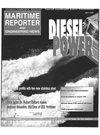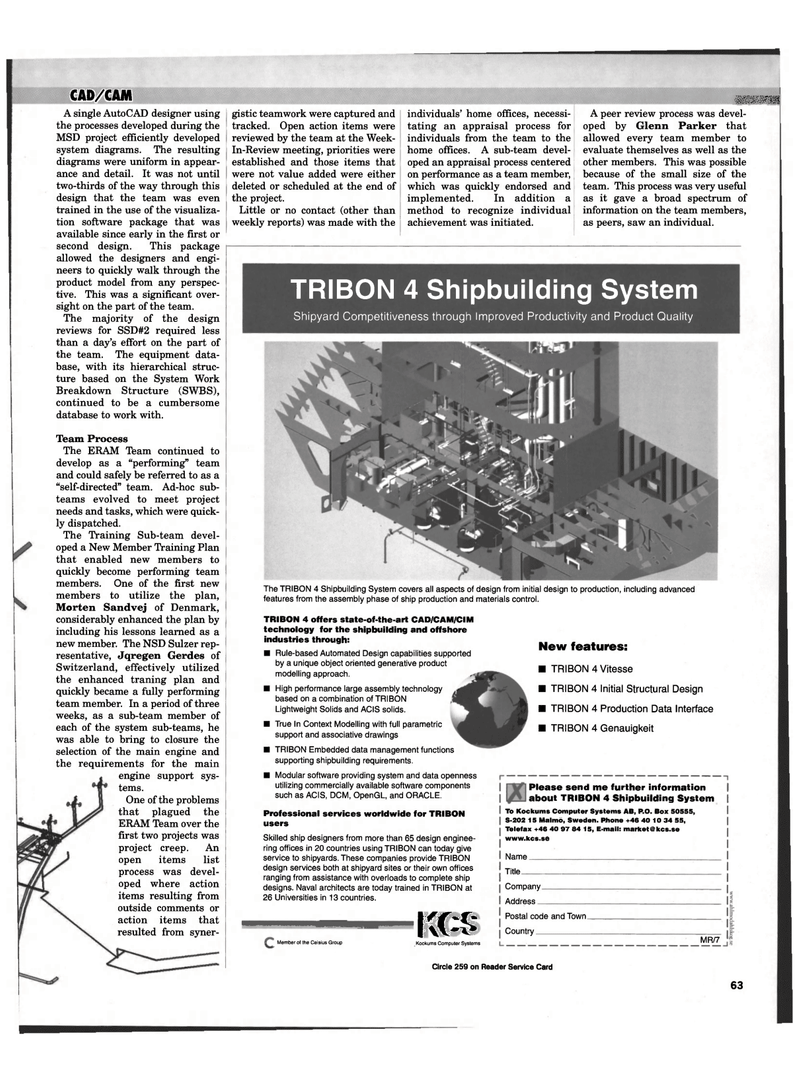
Page 63: of Maritime Reporter Magazine (July 1998)
Read this page in Pdf, Flash or Html5 edition of July 1998 Maritime Reporter Magazine
CAD/CAM
A single AutoCAD designer using the processes developed during the
MSD project efficiently developed system diagrams. The resulting diagrams were uniform in appear- ance and detail. It was not until two-thirds of the way through this design that the team was even trained in the use of the visualiza- tion software package that was available since early in the first or second design. This package allowed the designers and engi- neers to quickly walk through the product model from any perspec- tive. This was a significant over- sight on the part of the team.
The majority of the design reviews for SSD#2 required less than a day's effort on the part of the team. The equipment data- base, with its hierarchical struc- ture based on the System Work
Breakdown Structure (SWBS), continued to be a cumbersome database to work with.
Team Process
The ERAM Team continued to develop as a "performing" team and could safely be referred to as a "self-directed" team. Ad-hoc sub- teams evolved to meet project needs and tasks, which were quick- ly dispatched.
The Training Sub-team devel- oped a New Member Training Plan that enabled new members to quickly become performing team members. One of the first new members to utilize the plan,
Morten Sandvej of Denmark, considerably enhanced the plan by including his lessons learned as a new member. The NSD Sulzer rep- resentative, Jqregen Gerdes of
Switzerland, effectively utilized the enhanced traning plan and quickly became a fully performing team member. In a period of three weeks, as a sub-team member of each of the system sub-teams, he was able to bring to closure the selection of the main engine and the requirements for the main engine support sys- tems.
One of the problems that plagued the
ERAM Team over the first two projects was project creep. An open items list process was devel- oped where action items resulting from outside comments or action items that resulted from syner- •m gistic teamwork were captured and tracked. Open action items were reviewed by the team at the Week-
In-Review meeting, priorities were established and those items that were not value added were either deleted or scheduled at the end of the project.
Little or no contact (other than weekly reports) was made with the individuals' home offices, necessi- tating an appraisal process for individuals from the team to the home offices. A sub-team devel- oped an appraisal process centered on performance as a team member, which was quickly endorsed and implemented. In addition a method to recognize individual achievement was initiated.
A peer review process was devel- oped by Glenn Parker that allowed every team member to evaluate themselves as well as the other members. This was possible because of the small size of the team. This process was very useful as it gave a broad spectrum of information on the team members, as peers, saw an individual.
TRIBON 4 Shipbuilding System
Shipyard Competitiveness through Improved Productivity and Product Quality
The TRIBON 4 Shipbuilding System covers all aspects of design from initial design to production, including advanced features from the assembly phase of ship production and materials control.
TRIBON 4 offers state-of-the-art CAD/CAM/CIM technology for the shipbuilding and offshore industries through: • Rule-based Automated Design capabilities supported by a unique object oriented generative product modelling approach. • High performance large assembly technology based on a combination of TRIBON
Lightweight Solids and ACIS solids. • True In Context Modelling with full parametric support and associative drawings • TRIBON Embedded data management functions supporting shipbuilding requirements. • Modular software providing system and data openness utilizing commercially available software components such as ACIS, DCM, OpenGL, and ORACLE.
Professional services worldwide for TRIBON users
Skilled ship designers from more than 65 design enginee- ring offices in 20 countries using TRIBON can today give service to shipyards. These companies provide TRIBON design services both at shipyard sites or their own offices ranging from assistance with overloads to complete ship designs. Naval architects are today trained in TRIBON at 26 Universities in 13 countries. —1
Member of the Celsius Group
KCS
Kockums Computer Systems
New features: • TRIBON 4 Vitesse • TRIBON 4 Initial Structural Design • TRIBON 4 Production Data Interface • TRIBON 4 Genauigkeit
Please send me further information about TRIBON 4 Shipbuilding System
To Kockums Computer Systems AB, P.O. Box 50555,
S-202 15 Malmo, Sweden. Phone +46 40 10 34 55,
Telefax +46 40 97 84 15, E-mail: [email protected] www.kcs.se
Name_
Title
Company
Address _
Postal code and Town_
Country
MR/7
Circle 259 on Reader Service Card 63

 62
62

 64
64
